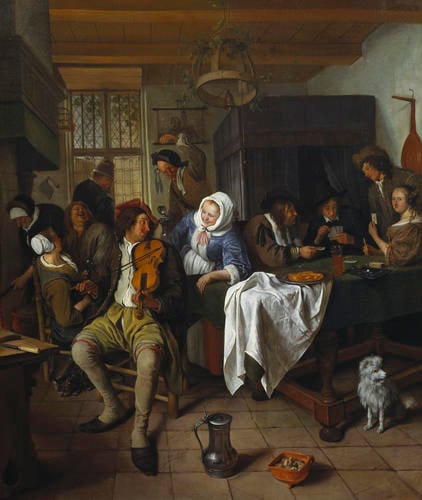-
1 of 253523 objects
Interior of a Tavern, with Cardplayers and a Violin Player c.1665
Oil on canvas | 81.9 x 70.6 cm (support, canvas/panel/stretcher external) | RCIN 405825

Jan Steen (Leiden 1626-Leiden 1679)
Interior of a Tavern, with Cardplayers and a Violin Player c.1665
-
This masterpiece dates from the mid 1660s and shows human folly and intemperance, depicted with Steen’s characteristic indulgence and comedy. The underlying joke is that, whatever they are doing, men have one thing on their minds. The violin player (note the slack bow of this date) leers over his shoulder at a girl, whom he seems to serenade. The laughing drinker near the hearth to the left (a self-portrait) sits by a young woman who holds her wine glass in a most suggestive position. An old crone stokes the fire, suggesting that the scene takes place in her tavern. Three men, ranging in age and type from old roué to lovesick youth, play cards with a woman, who shows us her ace of diamonds with a triumphant and knowing look. This vignette, taking place in front of a curtained bed and erect lute, suggests that the three of them are competing for her favours, but that whatever happens she will emerge the winner. Only the old man in the middle distance seems able to concentrate on drinking and dancing without letting himself get distracted by whoring. Hanging from the ceiling in the centre is a ‘bell-crown’ wreathed with vines; customers wishing to be served need only pull the cord to ring the bell. The print of a horseman on the wall in the background cannot be identified, but confirms many reports that art was to be found in the humblest tavern in seventeenth-century Holland, while perhaps suggesting that nobility which the other men in the scene seem to have forgotten.
Steen is not just a story-teller: he paints space and surface with the assurance of his contemporaries, Pieter de Hooch and Gabriel Metsu. Particularly remarkable is the observation of the soft light of the window in the background and the tactile sensation of the foreground tiles, pewter pot and earthenware dish of hot coals. The crowded middle-ground also makes it easy to ignore the well-constructed perspective of the scene which requires a very close view-point, which is why the foreground objects loom so large and seem to project with such effective illusionism.
Signed lower left: 'JSteen'Provenance
Purchased by George IV in 1818 for £170; recorded in the Dining Room at Carlton House in 1819 (no 73); in the Picture Gallery at Buckingham Palace in 1841 (no 83)
-
Medium and techniques
Oil on canvas
Measurements
81.9 x 70.6 cm (support, canvas/panel/stretcher external)
102.8 x 91.0 x 5.0 cm (frame, external)
Category
Object type(s)
Other number(s)